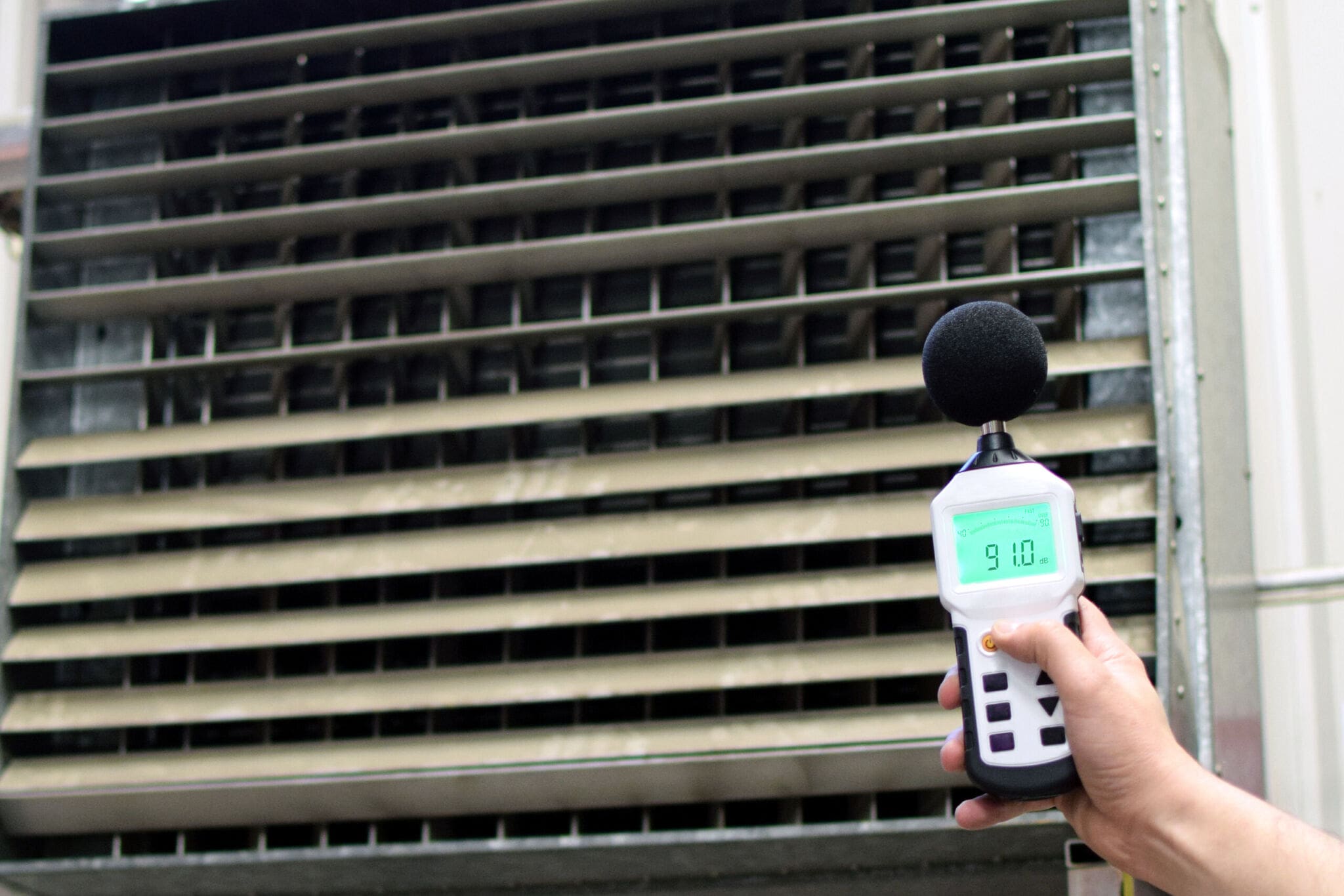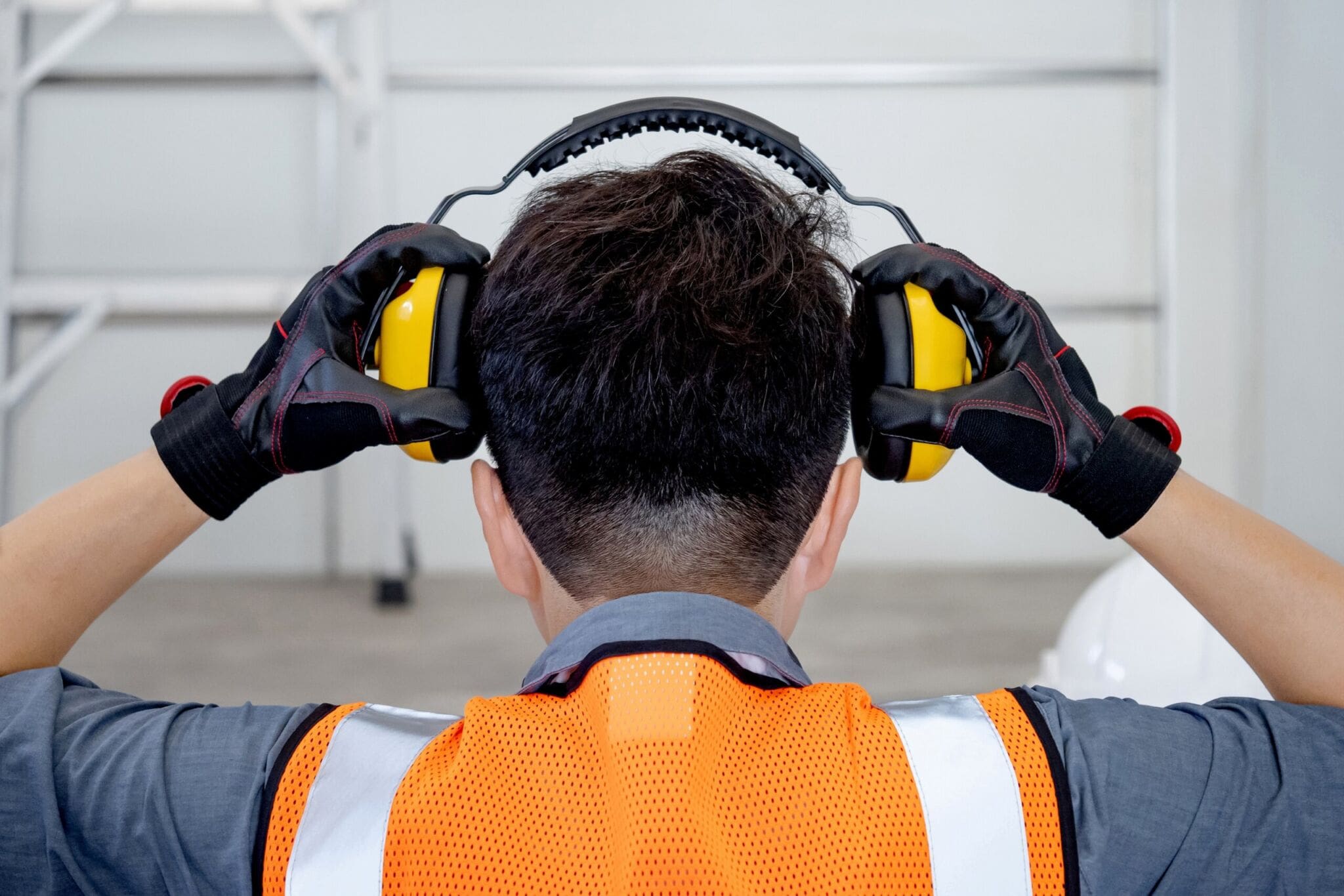In this article
Many workplaces are noisy, very few people work in silent or very quiet work environments and for most people noise at work is inevitable. Noise at work is not only the loud noises of, for example machine clatter or reverberation sounds of the power or pneumatic tools on a construction site, it can also refer to traffic or aircraft noise, loud music in clubs, theatres, or shops or general noise levels in public areas such as pubs, restaurants or even schools, play or sports areas for example.
Prolonged workplace noise can cause irreversible hearing damage when noise levels exceed safe thresholds, highlighting the need for consistent noise monitoring. There is an epidemic of occupational noise-induced hearing loss in the UK. Almost two million Britons already have hearing loss as a result of uncontrolled workplace noise and more than 2.3 million people in the UK are currently working in harmful levels of noise across industries as diverse as construction, catering, nightlife, manufacturing, and the military according to reports from the British Safety Council.
In the UK, employers have a legal responsibility to control noise at work and protect their employees from hearing damage. In this article we will look in more detail at the laws and regulations that require employers to prevent or reduce risks to employees’ health and safety from exposure to noise at work and the statutory duties and responsibilities that employers must adhere to.
The Control of Noise at Work Regulations 2005
In the UK every workplace must adhere to the Control of Noise at Work Regulations 2005, which places a statutory duty on employers to assess noise risks and implement measures to protect workers. As part of these regulations the Health and Safety Executive (HSE) expects employers to adhere to specific noise levels. Taking in to account the levels of exposure over a working day and the maximum noise (known as peak sound pressure), that employees are exposed to during the working day, the HSE sets out the following values:
Lower exposure action values:
- Daily or weekly exposure of 80 dB(A)
- Peak sound pressure of 135 dB(C)
Upper exposure action values:
- Daily or weekly exposure of 85 dB(A)
- Peak sound pressure of 137 dB(C
Exposure limit values:
- Daily or weekly personal noise exposure of 87 dB(A)
- Peak sound pressure of 140 dB(C)
Employers must act if noise meets or exceeds these levels, these actions range from conducting risk assessments (at lower values) to implementing mandatory hearing protection zones (at upper values). No one should be exposed to noise greater than 87dB(A) averaged over the working day and week or to a peak sound pressure of 140dB(C) or higher.
Levels of noise are measured in decibels (dB). When perceived by the human ear, these are usually expressed as an “A-weighted” decibel, or dB(A), to recognise that the ear is less sensitive to low frequencies of sound. To give you an idea of what these noise values actually sound like, a normal conversation is about 60 dB, noise from a vacuum cleaner, busy traffic or a police siren is around 80 dB, hairdryers, blenders, or power tools are around 90 dB, motorcycles around 100 dB, with 140 dB being the noise from fireworks, or a gunshot.
Most of us perceive one sound to be twice as loud as another when they are about 10 dB apart, so for example a power drill will sound twice as loud as a vacuum cleaner. Long or repeated exposure to sounds at or above 85 dB(A) can cause hearing loss.
The regulations set out specific duties for employers to take steps to reduce the risk of hearing damage to their employees and to provide them with appropriate hearing protection if necessary. More specifically, these duties under the Control of Noise at Work Regulations 2005 include:
- Assessing the risks to employees from noise at work
- Taking action to reduce the noise exposure that produces those risks
- Providing employees with hearing protection if the noise exposure cannot be reduced enough by using other methods
- Making sure the legal limits on noise exposure are not exceeded
- Providing employees with information, instruction, and training
- Carrying out health surveillance where there is a risk to health
It is important for employers to comply with these regulations to ensure the safety of their employees and to avoid penalties for non-compliance including fines and prosecution. The Health and Safety Executive (HSE) investigates complaints and enforces the regulations, breaching the regulations is a criminal offense, and depending on the severity of the offense, employers could face unlimited fines or 2 years imprisonment. These penalties are stringent and designed to ensure that employers take the necessary steps to manage workplace noise and to protect their employees from noise-induced hearing damage.

What does the law require employers to do?
Employers have a legal duty to ensure the health, safety, and welfare of their employees at work, as far as is reasonably practicable. This includes identifying and controlling risks, providing adequate information and training, and ensuring a safe working environment.
The Health and Safety at Work Etc. Act 1974 (HASAWA) requires employers to ensure a safe working environment and is the primary piece of legislation governing workplace health and safety in Great Britain. Section 2 of the act is the duty of employers to ensure the health, safety and welfare of all employees, meaning that employers must by law protect them from harm at work.
Working alongside HASAWA, there are other regulations such as the Management of Health and Safety at Work Regulations 1999, the Workplace (Health, Safety and Welfare) Regulations 1992, and those that refer to specific workplace risks, such as the Control of Noise at Work Regulations 2005 to implement, which are designed to keep workplaces compliant and safe.
A noise risk assessment is the first step for employers to take in order to comply with the law. This risk assessment must clearly identify where there may be a risk from noise in the workplace and who is likely to be affected. It should also estimate likely exposure to noise and identify measures to eliminate or reduce noise exposure. Employers are also required by law to record in an action plan anything they have identified as being necessary to comply with the law, setting out what they have done and what they are going to do, with a timetable and saying who will be responsible for the work.
These risk assessments and action plans will vary from workplace to workplace, but they must be carried out by a competent person, recorded, reviewed on a regular basis, and made available to HSE inspectors as and when required. The outcome of the noise risk assessment, the noise hazards identified and the actions being taken must also be explained to employees so that they fully understand the hazards, risks and safety measures.
Employers must make sure that the legal limits on noise exposure are not exceeded. Where it is not possible to reduce exposure to noise by for example amending work processes, implementing new, quieter, sound-reduced equipment or changing the design and layout of the workplace such as zoning for low noise emission, hearing protection must be supplied to, and used by anyone exposed. Employers must also define mark out “ear protection zones” in areas of the workplace where the noise levels are at or exceed the upper action level or peak action level. These must be clearly signposted in accordance with the Health and Safety (Safety Signs and Signals) Regulations 1996.
Where noise exposure exceeds 85dB(A), hearing protection must be provided to everyone exposed, and that includes any visitors to the workplace premises, with its use being mandatory, however it is good practice to provide suitable hearing protection to employees and to visitors exposed above 80dB(A). Accurate records should be kept to keep track of when hearing protection is issued to employees and visitors, and when it has been replaced. Employers must also carry out regular health surveillance of employees to ensure that there are no risks to health though noise exposure in the workplace.
Employers’ obligations
An employer’s first obligation to their employees is the prevention of risk of harm from excessive noise in the workplace. Prevention focuses on eliminating or minimising noise at its source. The most effective systematic method for noise risk reduction to safeguard employee health, safety and wellbeing is:
- Elimination – Removing or redesigning processes to avoid high noise altogether
- Substitution – Replacing loud machinery, equipment or tools with quieter alternatives and ensuring that tools, machinery and equipment are regularly maintained and lubricated to reduce noise levels
- Engineering Controls – These are strategies that isolate employees from workplace hazards such as installing sound barriers, damping materials, or enclosures
- Administrative Controls – These are measures that change workplace practices, procedures, or policies to reduce the likelihood of exposure to hazards such as limiting exposure time and providing training
- PPE – Supplying ear protection as the final line of defence.
Employers have an obligation to take the above steps to protect their employees’ health and wellbeing including their hearing, and this includes making sure that they have hearing protection if necessary. The Control of Noise at Work Regulations (2005) state that if employees are exposed to loud noise at work, the employer must have noise levels assessed, and they must keep a record of the assessment. When assessed, if noise exposure reaches 80 decibels (dB) or more, then employers are legally obliged to start taking action. Employers should also take action to ensure that any loud impulsive noise caused by the working environment, under no circumstances exceeds the maximum exposure limit value of 140db.
This action may include but is not limited to taking steps to reduce the noise levels, providing employees with information and training about the risks that they may encounter from noise, limiting employees’ exposure to noise, introducing health surveillance, including hearing checks, where a noise level of 85dB is exceeded, and making hearing protection available. The employer or the competent person on behalf of the employer must evaluate the effectiveness and adequacy of available hearing protection, in regard to the levels of noise that it is intended to protect against.
Employers have an obligation to promptly address any noise complaints and should never wait for situations to escalate. Employers need to be clear to employees about how to report workplace issues such as noise, and to whom they can report them to.
To manage exposure to noise at work effectively, it is important for employers to have policies in place that reflect their stance on noise in the workplace. As well as highlighting the employer’s responsibilities, including the need to take action when noises reach a certain level, the policy should include wording related to any violations of the policy.
The risk posed by noise at work
The impact of excessive noise exposure on employees can be vast and debilitating. As has already been mentioned, loud noise at work can damage employees’ hearing. In addition to damaging hearing, loud noise has the potential to impact an employee’s concentration, cause mental stresses, and break focus which can put themselves and others in potential danger.
There is a risk that excessive noise in the workplace can interfere with communications, making it harder to hear instructions or warnings and making people less aware of their surroundings. These issues can put people at risk of injury or even death.
Employers who do not comply with the Control of Noise at Work Regulations not only risk potential fines and penalties, they also risk insurance liability claims should any employee suffer harm if not effectively protected from workplace noise levels. Typical hearing damage claim settlements are around £5k -£8K, however the HSE estimates that the true cost for each claim is often an additional £7k -£29k.

Protecting yourself from noise at work
There are many ways a worker can protect themselves from noise at work. Employees must cooperate with their employer to ensure compliance with the regulations and follow their employer’s health and safety measures to minimise risk of harm from noise. Compliance with legal regulations and standards for workplace noise levels is vital to protect the health, safety and wellbeing of employees.
Hearing protection is one of the main sources of personal protection that if supplied by the employer, must be used according to the employer’s health and safety guidelines. Employees have a legal duty to properly use hearing protection when noise is at or above the upper exposure action values or when entering hearing protection zones. They must take notice of and comply with warning signs for example, at the entrance to areas where hearing protection is mandatory. They must also report any defects with the hearing protection equipment to their employer as soon as possible.
If not supplied, employees can request hearing protection if their work involves noise exposure above 80 dB. Additionally, if an employee has a history of hearing problems or uses hearing aids, they should inform their employer, who may need to provide specific hearing protection solutions.
Employees should also ensure that they use any available noise control equipment such as silencers or enclosures fitted to machinery. They should also report faulty noise control equipment on machines to their employer as soon as possible.
Taking quiet breaks or rotating tasks can help to reduce noise exposure in the workplace.
Attending regular hearing checks will allow employees to monitor their hearing thresholds and ensure that there are no changes to their hearing related to noise exposure at work. These hearing checks are important for the early detection of any hearing damage or loss, hearing damage or loss often develops gradually making it difficult to notice until it is advanced, sometimes years later. Regular screenings can catch problems early allowing for timely intervention and potentially preventing any further damage.
Any employee who has concerns about noise levels and / or protections in their workplace can report their concerns directly to their employer who has a legal obligation to take action to protect their employees from excessive noise. Alternatively, if they believe that their concerns are not being taken seriously, they can report their concerns to a union health and safety representative or to an official body, such as the Health and Safety Executive (HSE).

The health effects of noise at work
Ears are sensitive organs, and excessive noise at work and /or high noise exposure can damage the delicate hearing hair cells in the ear, causing noise-induced hearing loss (NIHL). Even a one-time exposure to very loud noise, such as a firework blast close to the ear, can cause NIHL. An extreme level of sound, around 120dB or louder, can cause physical pain although generally most people reach a point where they feel that sound is too loud and do something about it, long before they reach the threshold of pain.
Exposure to loud noise can also cause a change in hearing such as a ringing, buzzing, or hissing in the ears known as tinnitus, this can be temporary or permanent. These sounds can be so soft that they are barely noticeable, or so loud that they seem to block out sounds in the environment. In some cases tinnitus can be so severe, affecting people’s daily lives. People with severe tinnitus might have trouble concentrating or sleeping and over time, this can lead to frustration and depression.
Some people say that they feel more sensitive to sound, this is known as a condition called Hyperacusis, and it affects different people in different ways. For some, everyday sounds, that are typically considered normal, become painfully loud or uncomfortable to the individual. Anyone experiencing Hyperacusis should inform their employer particularly when working in noisy work environments. Employers should make reasonable adjustments such as providing ear protection in noisy environments even if they do not reach the minimum legal noise levels.
Long-term exposure to excessive noise can also result in chronic physical and / or mental stress, anxiety, high blood pressure, hypertension, fatigue, and decreased cognitive performance. If left unaddressed these issues may develop into other underlying health conditions.
Research by the University of Michigan has identified a linkage between noise exposures in a workplace and worker injuries and casualties. Their studies show that workers in a noisy workplace are much more likely to be hurt and much more likely to be killed on the job than a worker in a quiet workplace.
When should hearing protection be used?
Hearing protection is an item of personal protective equipment (PPE), and is used to prevent or minimise exposure to noise hazards in the workplace. The selection of appropriate PPE hearing protection depends on the specific working conditions and the type of noise occurring at the workplace. Requirements for hearing protection are regulated accordingly and classified into the following types:
- Earplugs
- Earmuffs
- Hearing protection helmets
- Noise protection suits
According to The Control of Noise at Work Regulations 2005, the exposure level at which employers need to provide PPE hearing protection is a daily or weekly personal noise exposure of 85 dB. Those who are working in noise levels between 80 dB (lower action level) and 85 dB must be provided with suitable hearing protection on request. The noise exposure limit is 87 dB, this figure takes into account any reduction in exposure provided by hearing protection. Employees must not be exposed to noise levels exceeding 87 dB, whether they are wearing ear protection or not.
A suitable and sufficient risk assessment must be carried out, prior to an employer providing PPE hearing protection for their employees, to determine that potential risk cannot be mitigated through other control measures. Employers must not use hearing protection as an alternative to controlling noise by technical and / or organisational means.
Where it has been assessed that hearing protection is required, the provision of that hearing protection must be suitable and appropriate to the work-task and its associated risk and the equipment must fit the user properly. Wherever hearing protection has been identified as being required as part of the control measure provision, then this must be provided at no cost to the employee and this includes any replacement of such equipment. It is also the responsibility of the employer to ensure that employees receive correct information / training on the use of any hearing protection supplied.
As with all PPE, hearing protection should be checked to make sure it works effectively and that:
- It remains in good, clean condition
- Earmuff seals are undamaged
- The tension of the headbands is not reduced
- There are no unofficial modifications
- Compressible earplugs are soft, pliable and clean
Conclusion
Excessive noise in any workplace although commonplace is not unavoidable. There are lots of actions that employers can take to remove or reduce it. By prioritising the reduction of workplace noise pollution, complying with legal regulations and standards for workplace noise levels and implementing appropriate strategies, employers can effectively reduce noise pollution and create a more conducive work environment to protect the health, safety and wellbeing of their employees.






